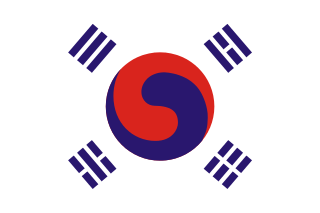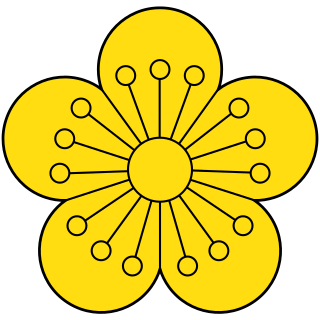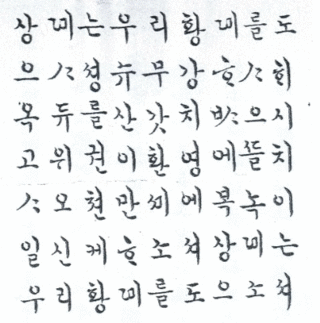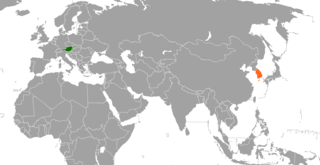
The Gabo Reform, also known as the Kabo Reform, describes a series of sweeping reforms suggested to the government of Korea, beginning in 1894 and ending in 1896 during the reign of Gojong of Korea in response to the Donghak Peasant Revolution. Historians debate the degree of Japanese influence in this program, as well as its effect in encouraging modernization.

The Korean Empire, officially the Empire of Korea or Imperial Korea, was a Korean monarchical state proclaimed in October 1897 by King Gojong of the Joseon dynasty. The empire stood until Japan's annexation of Korea in August 1910.

The Goethe-Institut is a non-profit German cultural association operational worldwide with 159 institutes, promoting the study of the German language abroad and encouraging international cultural exchange and relations. Around 246,000 people take part in these German courses per year.

The Veritable Records of the Joseon Dynasty are the annual records of Joseon, the last royal house to rule Korea. Kept from 1392 to 1865, the annals comprise 1,893 volumes and are thought to be the longest continual documentation of a single dynasty in the world. With the exception of two sillok compiled during the colonial era, they are the 151st national treasure of South Korea and listed in UNESCO's Memory of the World registry. The texts are also known as the Annals of the Joseon Dynasty or the True Record of the Joseon Dynasty.

Deoksugung (Korean: 덕수궁) also known as Gyeongun-gung, Deoksugung Palace, or Deoksu Palace, is a walled compound of palaces in Seoul that was inhabited by members of Korea's royal family during the Joseon monarchy until the annexation of Korea by Japan in 1910. It is one of the "Five Grand Palaces" built by the kings of the Joseon dynasty and designated as a Historic Site. The buildings are of varying styles, including some of natural cryptomeria wood), painted wood, and stucco. Some buildings were built of stone to replicate western palatial structures.

Gyeongbokgung, also known as Gyeongbokgung Palace, was the main royal palace of the Joseon dynasty. Built in 1395, it is located in northern Seoul, South Korea. The largest of the Five Grand Palaces built by the Joseon dynasty, Gyeongbokgung served as the home of the royal family and the seat of government.
Yi Hong is a South Korean model and entertainer. She is descendant of Joseon royalty; she is the eldest daughter of Yi Seok by his second wife, Donkgo Jeonghui, and a great-granddaughter of Emperor Gojong of Korea.

The House of Yi, also called the Yi dynasty, was the royal family of the Joseon dynasty and later the imperial family of the Korean Empire, descended from the Joseon founder Yi Seong-gye. All of his descendants are members of the Jeonju Yi clan.

The Japan–Korea Treaty of 1905, also known as the Eulsa Treaty, Eulsa Unwilling Treaty or Japan–Korea Protectorate Treaty, was made between the Empire of Japan and the Korean Empire in 1905. Negotiations were concluded on November 17, 1905. The treaty deprived Korea of its diplomatic sovereignty and made Korea a protectorate of Imperial Japan. It resulted from Imperial Japan's victory in the Russo-Japanese War in 1905.

The "Patriotic Hymn of the Great Korean Empire" was the national anthem of the Korean Empire during the 1900s. It was the first and only national anthem of a unified Korean state to date.

Lee Wan-yong, also spelled Yi Wan-yong or Ye Wan-yong, was a Korean politician who served as the 7th Prime Minister of Korea. He was pro-Japanese and is best remembered for signing the Japan–Korea Annexation Treaty, which placed Korea under Japanese rule in 1910.

Gwanghwamun is the main and largest gate of Gyeongbok Palace, in Jongno-gu, Seoul, South Korea. It is located at a three-way intersection at the northern end of Sejongno. As a landmark and symbol of Seoul's long history as the capital city during the Joseon Dynasty, the gate has gone through multiple periods of destruction and disrepair. The most recent large-scale restoration work on the gate was finished and it was opened to the public on August 15, 2010.
Russians in Korea do not form a very large population, but they have a history going back to the Korean Empire. The community of Russian subjects/citizens in Korea has historically included not just ethnic Russians, but members of minority groups of Russia as well, such as Tatars, Poles, and, more recently, return migrants from among the Koryo-saram and Sakhalin Koreans.
Karl Ivanovich Weber was a diplomat of the Russian Empire and a personal friend to King Gojong of Korea's Joseon Dynasty. He is best known for his 1885–1897 service as Russia's first consul general to Korea.
Mongolians in South Korea form the world's largest population of Mongolian citizens abroad.
Kim Min-ki is a South Korean singer, composer, and playwright. He is best known for his 1970 song, "Morning Dew," and for his 1994 Korean adaptation of the German musical, Linie 1.

Foreign relations exist between Austria and South Korea. Diplomatic relations between the two countries were established on May 22, 1963.
Ferdinand Krien was the German consul in Joseon Dynasty Korea from 1887 to 1898.
Afanasii Ivanovich Seredin-Sabatin was a Russian steersman-pilot and reporter for an English newspaper, but is best known as the first European (Russian) architect to live and work in the Korean Empire from (approximately) 1890 to 1904. He built a number of palaces in European style within the city of Seoul. He also built the first Russian Legation building, also in the city of Seoul. This building is a historical site because shortly after the Japanese invasion of Korea, in 1895, when the Korean Queen Min was assassinated by the Japanese, King Gojong and his son were given refuge in the Russian Legation for a year.

The Hangang Railway Bridge crosses the Han River in Seoul, South Korea and connects Noryangjin Station and Yongsan Station.












